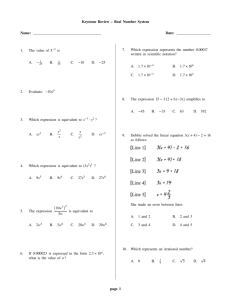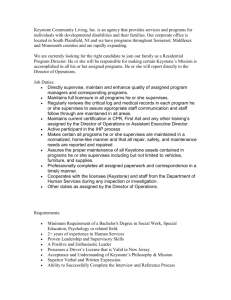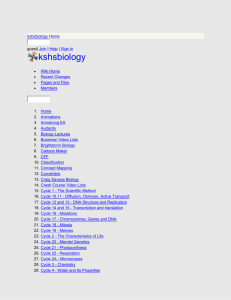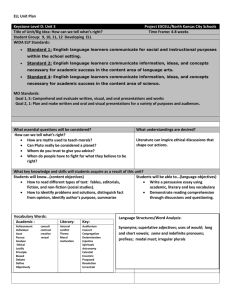Keystone Powerpoint
advertisement
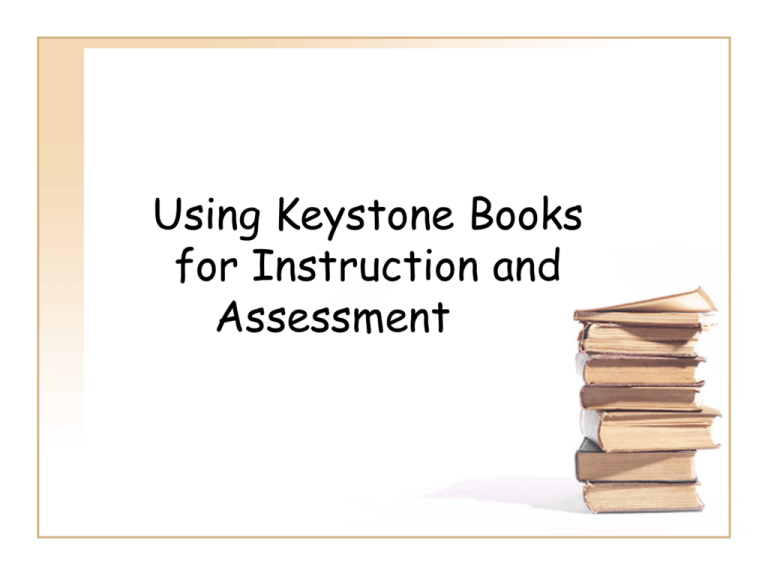
Using Keystone Books for Instruction and Assessment Keystone Assessment Books? Original Goal •To develop a list of high-quality leveled texts from multiple publishers to use for frequent progress monitoring. •To prevent overuse of published assessment ‘kits’ (DRA, Benchmark Reading Assessment and Dominie Reading Assessment) that are integral to school district assessments. Keystone Assessment Books? In an effort to differentiate between the numerous associations for “benchmark books” in education today we chose Keystone as the descriptor for the UALR assessment collection. The associations conveyed by the term “Keystone” are: A central supporting element of a larger structure such as a theory or organization, without which the whole structure would collapse, a central principle on which all depend. (The definition) Purpose of Keystone Book Collection A Keystone book is a reliable exemplar selected for each level on the gradient. Keystone books are used to document student reading progress over time or to place students in initial instructional groups. Using books that allow us to observe a student’s reading behaviors at the instructional level is a central supporting element necessary for teachers in the on-going development of the literacy processing system (the larger structure). Process Identify a large variety of books at each level of the gradient from a variety of publishers. The original list was compiled by Reading Recovery teachers and Literacy Coaches from Conway School District in Arkansas. It represented a limited number of publishers in the collection. Process 2008 More books were added to the list with a larger variety of publishers represented. Reading Recovery Teachers and Literacy coaches from the Russellville, AR School District reviewed the existing book introductions and suggested new books to be added. An On-going Process Over a Four Year Period Beginning Spring 2010 In collaboration with intervention teachers, literacy coaches, and university faculty the large collection of Keystone Books were field-tested and the list was refined based on teacher feedback. An On-going Process Over a Four Year Period Beginning Spring 2010 At the end of Year Three, a team of Comprehensive Intervention Model (CIM) trainers from five universities reviewed the teachers’ feedback, selected the most suitable books, and created standardized book introductions. Validating the Collection This list became the testing packet* that was used in the research study. Participants in the study included 47 reading teachers 24 schools 9 states 806 K-2 students * See collection available from Song Lake books. Validating the Collection “The findings provide strong evidence that the Keystone Collection (Levels A-M) represents a valid and reliable method of estimating children’s text-reading level through an authentic, teacher-administered reading task.” Dorn, L.J., Forbes, S., Poparad, M.A. & Schubert, B. (Eds). (2015). Changing Minds, Changing Schools, Changing Systems: A Comprehensive Literacy Design for School Improvement. Hameray Publishing Group. Validating the Collection You can access more information about the validation study in Chapter 3 of Changing Minds, Changing Schools, Changing Systems: A Comprehensive Literacy Design for School Improvement Dorn, L.J., Forbes, S., Poparad, M.A. & Schubert, B. (Eds). (2015). Changing Minds, Changing Schools, Changing Systems: A Comprehensive Literacy Design for School Improvement. Hameray Publishing Group. The Keystone Collections* A complete list of the books with book introductions and directions can be downloaded from www.ualr.edu/literacy Choose “Teaching Resources” To order the set of books (70 titles from 11 publishers) used in the study download the order form from Song Lake books available at the above site. Original sources for text levels. Elements of a good book orientation Literacy Lessons II page 91 M.M. Clay (2005) “Having carefully selected a book for a particular child the teacher reads it herself, thinking about the best ways to orient this child to this book. Make the child familiar • with the story • with the plot • with the phrases of language that he might never have heard, • with unusual names and new words, • and with old words used in an unusual way” Create short, standardized introductions for each Keystone book two or three sentences that focus on the main idea of the book including genre or story structure use some of the language, which might include names of characters use specific or technical vocabulary, or other unusual language structures An Observation Survey of Early Literacy Achievement M.M. Clay 2013 p.2 “To use systematic observation the teacher has to set time aside from teaching to become a neutral observer.” Use running records. There are three important reasons why the Keystone Books can be useful for progress monitoring: 1) represent a wide variety of publishers, authors, text types, genres, formats, and writing styles; 2) are not aligned with any particular publisher; and 3) can be used interchangeably for guided reading groups and progress monitoring. A set of directions provides for systematic observation, a standard task, a standard way of setting up the task (administration). Attach introductions to back cover and include the following: Book title Level Number of running words Number of errors a reader can make before the score goes below 90 percent accuracy Protocol for Using Level 1-16 Benchmark Books • Teacher will read the introduction aloud and then have the student read the story aloud • 90% accuracy or above with good processing is probably a good instructional level • Comprehension Guides and Fluency rubric will be used to determine the “just right” level. Protocol for Using Benchmark Books Higher Than Level 16 • Teacher will read the introduction aloud and then have the student read the text aloud • Teacher takes running record on a selected passage. 90% accuracy or above with good processing is probably a good instructional level • Check comprehension Protocol for Using Benchmark Books Higher Than Level 16 • Teacher then asks the student to read a short section silently. • Teacher checks comprehension • Comprehension Guides and Fluency rubric will be used to determine the “just right” level Comprehension Guides and Fluency rubrics are available in Interventions that Work Dorn, L.J. & Soffos, C (2012). Interventions that Work. Boston,MA: Pearson Why are you assessing the student? to determine, in general, the instructional level? to determine the level the student can read different genres? What makes a book hard? Structure Vocabulary Sentence length A reader’s prior knowledge Narrative or nonfiction Mondo Publishing Book Shop Series GRL B Interv. Level 3 Introduction: The boy in this book hits the ball but it went into the wrong place. Will he get a home run? Introduction: This book is about living things and how many legs each one has. Mondo Book Shop Series GRL C Interv. Level 6 Title: Why Caterpillars Become Butterflies Level: GRL G Word Count: 198 Errors: 21 Genre: Animal Fantasy Fiction Introduction: Once there was a lonely caterpillar. He called out to see if there were others who could come out. Read to find out how these caterpillars changed so they could get together. Item #1404536930 Wright Group/Gear Up Pioneer Valley Educational Press Literacy Footprints Nonfiction Set 7 GRL G Interv. Level 12 Title: Butterflies Level: GRL G Word Count: 213 Errors: 23 Genre: Non Fiction Introduction: This books tells us all about butterflies, the parts of their body, how they eat and how they go through metamorphosis. That means changing from an egg to a caterpillar to a chrysalis and finally a butterfly. Read to find out how that happens. Item #NFS72 Pioneer Valley Educational Press Where are we now in the process? A data base for the collection is complete. A smaller set of books identified for research purposes. Directions for administration is complete Comprehension guides are complete In the process of writing prompts for writing about reading. In the process of adding books from new publishers to the collection. Finalizing the Process This is a PILOT Project We expect anyone using these books as presented for assessment will provide us with feedback. The UALR committee will use this feedback to revise the documents into their final form for distribution. This will continue to be a work in progress.

